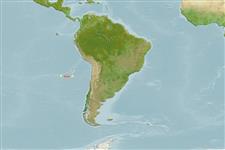Environment: milieu / climate zone / distribuzione batimetrica / distribution range
Ecologia
marino benthopelagico; distribuzione batimetrica 180 - 400 m (Ref. 6181). Deep-water; 20°S - 27°S, 90°W - 81°W (Ref. 6181)
Southeast Pacific: known only from seamounts of Nazca Submarine Ridge and adjacent parts of Sala y Gomez Ridge.
Size / Peso / Age
Maturità: Lm ? range ? - ? cm
Max length : 43.0 cm SL maschio/sesso non determinato; (Ref. 6181); Età massima riportata: 15 anni (Ref. 6204)
Spine dorsali (totale) : 18; Raggi dorsali molli (totale) : 15 - 18; Spine anali: 2; Raggi anali molli: 12 - 14; Vertebre: 34. Lateral line branching below the 5th to 7th spine of the first dorsal fin, usually ending below the third to the last spine of the first dorsal fin. The lower branch runs mid laterally, sometimes undulating on caudal peduncle. Body is entirely scaled at a length of over 20 cm SL. Pyloric caeca 7 or 8. Body color is brown with silvery tint; anterior 2 membranes of the first dorsal fin black, the rest of the fin black edged; the posterior part of the pectoral fin is black.
Body shape (shape guide): elongated; Cross section: compressed.
Feeds on squid and fish. Matures at about 25 cm.
Life cycle and mating behavior
Maturità | Riproduzione | Deposizione | Uova | Fecundity | Larve
Nakamura, I. and N.V. Parin, 1993. FAO Species Catalogue. Vol. 15. Snake mackerels and cutlassfishes of the world (families Gempylidae and Trichiuridae). An annotated and illustrated catalogue of the snake mackerels, snoeks, escolars, gemfishes, sackfishes, domine, oilfish, cutlassfishes,. scabbardfishes, hairtails, and frostfishes known to date. FAO Fish. Synop. 125(15):136 p. (Ref. 6181)
IUCN Red List Status (Ref. 130435: Version 2025-1)
Threat to humans
Harmless
Human uses
Strumenti
Special reports
Download XML
Fonti Internet
Estimates based on models
Preferred temperature (Fonte Biblio.
123201): 10.6 - 11.1, mean 10.8 °C (based on 10 cells).
Phylogenetic diversity index (Fonte Biblio.
82804): PD
50 = 0.5078 [Uniqueness, from 0.5 = low to 2.0 = high].
Bayesian length-weight: a=0.00372 (0.00167 - 0.00826), b=3.10 (2.91 - 3.29), in cm total length, based on LWR estimates for this (Sub)family-body shape (Ref.
93245).
Trophic level (Fonte Biblio.
69278): 4.5 ±0.62 se; based on food items.
Resilienza (Fonte Biblio.
120179): Basso, tempo minimo di raddoppiamento della popolazione 4.5 - 14 anni (tmax=15).
Fishing Vulnerability (Ref.
59153): Moderate vulnerability (41 of 100).
🛈
